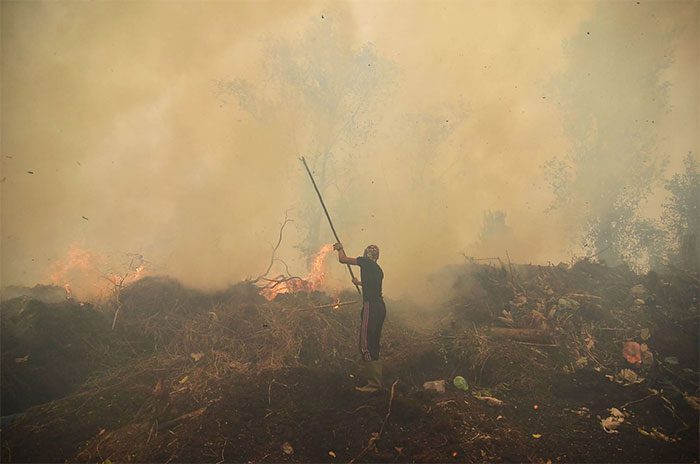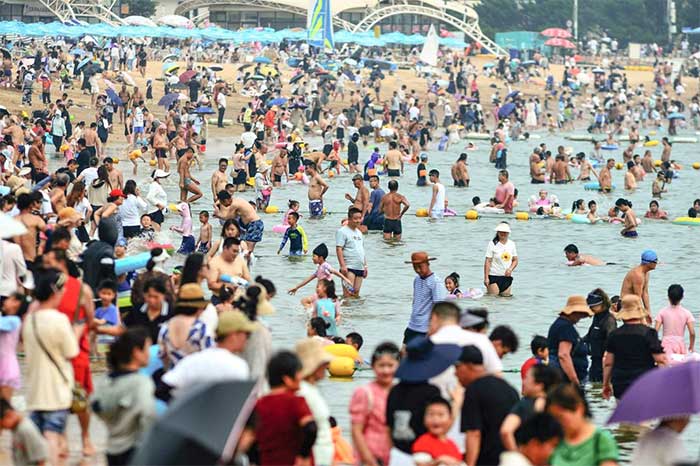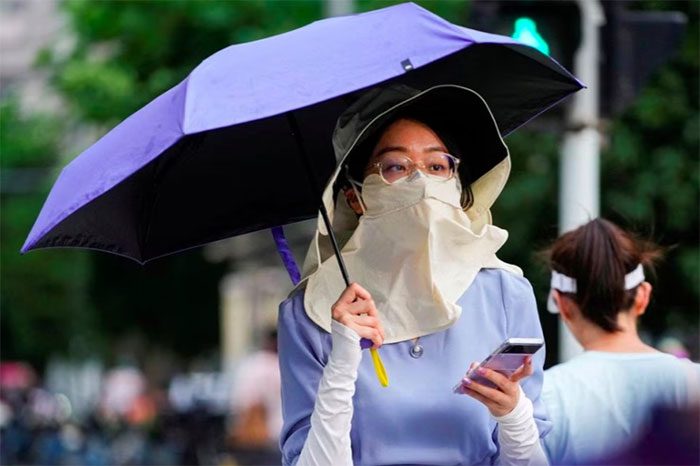In the coming weeks, residents of Singapore may develop a habit of checking temperature alerts every morning upon waking up, before heading to work or school.
According to the South China Morning Post, this scenario seemed unimaginable less than a decade ago. However, it is now something that people in this Asian financial hub will have to get used to as the city government plans to issue regular alerts about extreme weather.

A man jumps into a stream to escape the heat in the outskirts of Srinagar, India, on July 5. (Photo: EPA-EFE).
Last week, climate scientists confirmed that July was the hottest month on record. Observers from the United Nations and the European Union (EU) also noted that the recent heatwave had not been seen for thousands of years, warning that this is only a glimpse of future climate conditions.
According to an analysis by Dr. Karsten Haustein, a climate scientist at Leipzig University, this extreme weather phenomenon last occurred 120,000 years ago.
The Ministry of Sustainability and the National Environment Agency of Singapore stated: “With climate change, many countries around the world, including Singapore, are experiencing rising temperatures. Therefore, it is crucial for citizens to learn how to adapt.”
Not only Singapore, many other countries across Asia must also learn to adapt to extreme weather, as this region is particularly vulnerable to climate change.
Recently, floods swept through northern India. Meanwhile, a region in the Xinjiang province of China recorded temperatures of 52.2 degrees Celsius, breaking the previous record of 50.6 degrees Celsius set in 2017.
Extreme weather is partly due to El Niño—a weather phenomenon that disrupts rainfall patterns every few years. Temperatures in Asia tend to rise during El Niño years, often making the air more humid and hotter. Scientists believe that this type of weather will become more common as humans continue to burn fossil fuels.
Ms. Friederike Otto, a senior lecturer in climate science at the Grantham Institute for Climate Change and the Environment at the London School of Economics and Political Science, remarked: “As long as humans continue to burn fossil fuels, we will witness an increasing number of similar extreme weather events. But even if we stopped burning fossil fuels right now, temperatures would not decrease. Therefore, we will have to live with heatwaves like the ones we are experiencing now.”
Heatwaves also impact the health of vulnerable communities, who often have limited access to public health services.
Ms. Marina Romanello, the executive director of Lancet Countdown, an organization focused on climate change and health, stated that heat-related mortality rates have increased by approximately 70% globally since the early 2000s.
“The impact of heat on human health is enormous. Hot weather severely diminishes the working capacity of many people, such as farmers working up to 12 hours a day in the fields,” Ms. Romanello said, noting that in 2021 alone, rising temperatures resulted in the loss of about 470 billion working hours globally, causing financial damages of around $700 billion.
In the Asia-Pacific region, there are currently about 450 million smallholder farmers. Scientists state that the poorest countries—such as Bangladesh, Nepal, Pakistan, and Myanmar—often suffer the most from the impacts of climate change. In vulnerable coastal areas, residents typically have low incomes and lack social safety nets.

Residents extinguish a forest fire in Kampar, Riau province, Indonesia in 2019. (Photo: AFP).
High temperatures also pose other dangers, including devastating wildfires.
Last week, the Indonesian government reported that the area prone to fires had doubled from July 17 to July 23 due to dry weather. This serves as a harsh reminder of the horrific forest fire in 2015, which enveloped Southeast Asia in thick smoke for five months.
The Indonesian meteorological agency noted that the country is expected to experience its harshest dry season since 2019 in the latter half of the year, partly due to the El Niño phenomenon.
Mr. Aravindan Srinivasan, director of thematic cooperation at the nonprofit Asian Venture Philanthropy Network, which aims to mitigate climate change, stated that the hot and humid conditions also increase the risk of outbreaks of mosquito-borne diseases such as dengue fever and malaria. These diseases are already common in Southeast Asia, South America, and Sub-Saharan Africa, but they are now beginning to spread to previously uncharted territories like Europe.
However, densely populated Asia remains at the highest risk. Mr. Srinivasan pointed out that five of the most vulnerable countries to climate change in the world—India, China, Bangladesh, Pakistan, and Indonesia—are all located in the Asian region.
Prioritizing the health of the planet

People flock to the beach amid the heatwave in Qingdao, Shandong province, China. (Photo: AFP).
Mr. Srinivasan’s organization has 600 members, including philanthropists and large companies, eager to fund renewable energy projects in Asia. The organization has been active in India for the past six months and plans to soon expand its operations to China and Southeast Asia.
Mr. Srinivasan stated that this nonprofit network collaborates with grassroots businesses and works with various organizations that partner with the government to implement community-based problem-solving programs, such as painting roofs to reduce heat. However, he noted that these initiatives often require funding.
“We must consider both sides of the issue—mitigation and adaptation,” he stated.
Mitigation and adaptation are becoming increasingly important as extreme weather leads to rising electricity demand, threatening to produce more emissions.
Recently, some cities in China have broken electricity consumption records. Shanghai, in particular, has been burning hundreds of tons of coal per hour to cool down the city. People in other countries, such as Vietnam, are also facing prolonged power outages.
Ms. Julie Arrighi, director of the Red Crescent Climate Center in the Netherlands, stated that balancing energy demand and reducing emissions is key to preventing longer and more intense heatwaves.

A woman shields herself from the sun with a hat, mask, and umbrella amid a heatwave warning in Shanghai, China. (Photo: Reuters).
Experts indicate that Asian countries often prefer to switch to coal energy, as this fuel is readily available in the region, but this strategy is fraught with risks.
Mr. Grant Hauber, strategic energy finance advisor at the Institute for Energy Economics and Financial Analysis, explained that thermal power plants—facilities that operate using energy produced by boilers, usually powered by coal or gas—do not perform efficiently in excessively hot weather.
He noted that these facilities often experience reduced capacity during extreme heat. According to the energy consulting firm Ember, about 62% of the world’s electricity was generated from fossil fuels in 2021.
However, experts believe that in the long run, Asia may transition to green energy sources.
“An increasing amount of renewable energy can fill the supply gap,” Mr. Hauber stated, adding that solar energy has become a savior for households during power outages amid sweltering heat in Texas (USA) last month.


















































